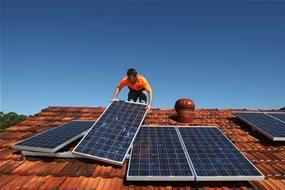Australia gets about 10 per cent of its electricity from renewable energy and were shooting for double that by the end of the decade under our national 20 per cent Renewable Energy Target.
So far this policy has delivered thousands of jobs and billions of dollars of investment, and is capable of much more if the Federal Government can resist tinkering with it. It’s a classic case of “if it ain’t broke, don’t fix it”.
The idea of producing pollution-free power just seems to make sense to people, which is why between 80-90 per cent of people voice their support whenever a poll does the rounds. So far our politicians have acted to give them what they want.
Business often talks about moving goalposts, but changing the way the scheme works now really would be like the AFL or the NRL changing the rules of the game halfway through the premiership season. It would mean that all the pre-season training, all the effort to recruit the best players and all the hours spent on strategy were irrelevant
Right now, major investors are mostly watching cautiously from the sidelines as the Federal Government’s Climate Change Authority reviews the Renewable Energy Target.
The authority is under pressure from a range of energy companies who are lobbying hard to have the target scaled back, or even dumped altogether, so they can carve out a bigger slice of the pie for either gas or coal.
But the effect of making major changes to the Renewable Energy Target wouldn’t be just to lose a few matches – it would be measured in the hundreds of millions of dollars in investment and the thousands of jobs that would be lost.
Ultimately it would be like a season where there was no winner – only losers.
All over the world, interest in the renewable energy sector is at a record high, with US$257 billion being pumped into it last year across the globe.
Over the past decade, investors in Australia have chipped in around $18.5 billion of their own, with more than $3.5 billion in projects under construction. Large clean-energy projects supply enough clean energy for the equivalent of 2.1 million households. A further 1.5 million homes have solar panels or solar hot water. And there’s potentially much more to come.
Vested interests that want to see the target changed or removed have been making a big deal about its costs. But those costs make up only a small percentage of the average power bill – 7 per cent versus the 40 per cent contributed by upgrading poles and wires.
What’s more, the costs of meeting the target are going down as renewable energy falls in price and government incentives to buy solar power are wound back.
At the moment you’re looking at less than $2 per week for an average household going towards renewable energy. In 2020 it will be about half that, provided the current Renewable Energy Target remains unchanged. That’s a small price for tens of thousands of jobs, billions of dollars of investments and to protect us from the future impact of rising gas prices.
While speculation about the future of the carbon price remains, the Renewable Energy Target has been one of the few investment-grade policies that Australia’s electricity generators have been able to rely on. This is largely because it is supported by all sides of politics.
The renewable energy industry has repeatedly outperformed expectations, forecasts and previous targets. If the government can resist the urge to intervene in the Renewable Energy Target, clean energy companies and investors can start to get on with the business of kicking some serious goals for Australia.
Kane Thornton is deputy chief executive of the Clean Energy Council



